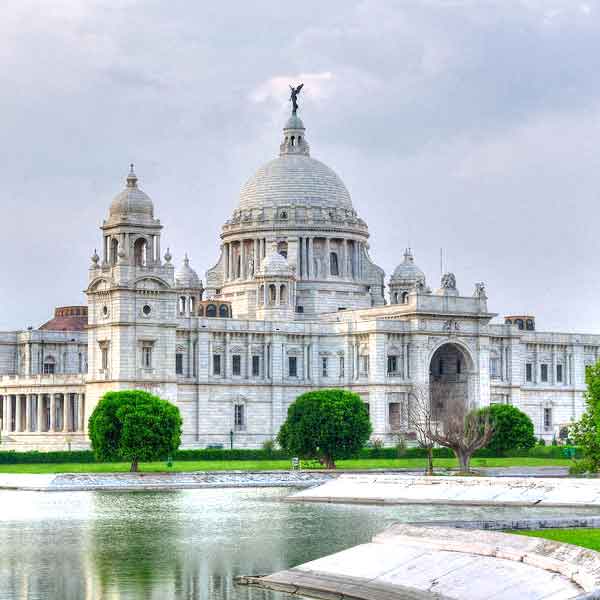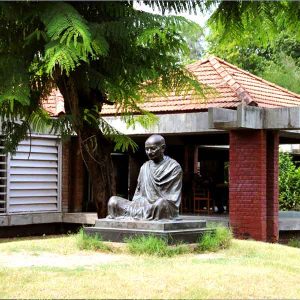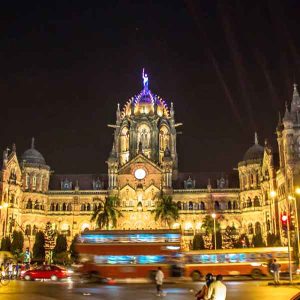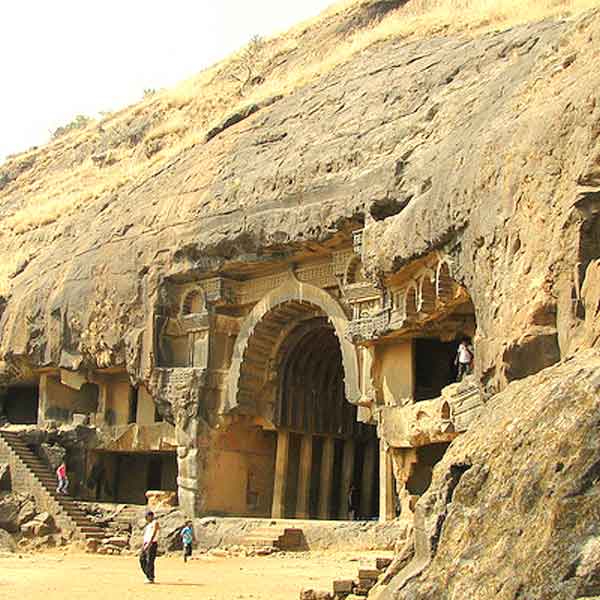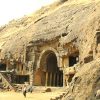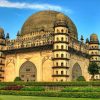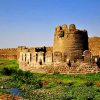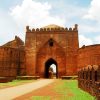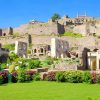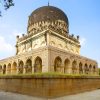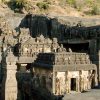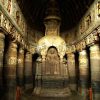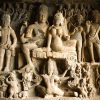Day 01: Arrive Mumbai.
Meet and assist upon arrival, with transfer to domestic airport to board flight for Pune. Overnight in Pune.
Day 02: Pune. Day excursion to Karla & Bhaja Caves.
A short distance from Pune, are several Buddhist rock-cut caves and forts worth visiting for those interested in ancient Indian history. The Karla Caves represent the best example of rock-cut architecture in this region, famous for the two rows of decorated pillars that line the main hall. Started by the Hinayana Buddhists in the 1st century BC, these caves were later taken over by the Mahayana sect.
Exactly opposite the Karla ridge lie the Bhaja Caves. Bhaja Caves date back to the 2nd century BC. The rock-cut architecture here is beautiful and better preserved than Karla. Overnight in Pune.
Day 03: Pune to Bijapur.
Morning, long drive to Bijapur. Rest of the day at leisure. Overnight in Bijapur.
Day 04: Bijapur to Gulbarga.
Full day guided tour of Bijapur. A provincial centre under the Bahamanis, Bijapur became the capital of an independent dynasty, the Adil Shahis for about 200 years. The period of greatest architectural and artistic achievement was late 16th and early 17th centuries, particularly under the rulers Ali I and Ibrahim II. While the most sophisticated buildings and miniatures were produced during Ibrahim II’s reign, the most imposing monument, the Gol Gumbaz was built by his successor Muhammad I. Its construction was completed in the year 1656. The most amazing part of this monument is its huge dome. The dome is 44 meters in diameter, which made it the second largest dome in the world when it was constructed. The largest being the Santa Maria del Fiore in Florence which is 45.5 meters in diameter.
Later drive to Gulbarga. Overnight in Gulbarga.
Day 05: Gulbarga to Hyderabad.
Morning visit to view the Gulbarga Fort. Built in around 13th century Gulbarga fort has 15 towers, large buildings, temples, stables, ammunition godowns, carriages, 26 guns and several beautiful courtyards. This huge historical structure reflects the grandeur of the Bahamani dynasty. Built inside the Gulbarga Fort is a unique mosque with a huge dome and smaller ones as embellishments. It was built in 1367 AD, by a Spanish (Moorish) architect, with arched doorways on the same lines as that of the Great Cathedral-Mosque of Córdoba in Spain.
Later drive to Hyderabad en route visiting Bidar. Originally built in 8th century and strengthened and renovated in 1428 by Sultan Ahmad Shah Bahamani, the Bidar fort boasts of a dominating presence in the Bidar landscape. Nestled inside this moated fort is the royal town dotted with crumbling ruins of the bastions and gates, royal baths and kitchens, audience halls, and pleasure pavilions. Among the congregation of royal palaces, the Rangin Mahal stands out for its sheer elegance and exquisite carvings. Overnight in Hyderabad
Day 06: Hyderabad.
Full day guide tour of Hyderabad. Also known as ‘The City of Nizams’ and ‘The City of Pearls’, Hyderabad is today one of the most developed cities in the country and a modern hub of information technology. Hyderabad has been governed by a succession of Muslim Nawabs, although the city’s culture, cuisine and style reflects the mix of Muslim and Hindu. Your sightseeing tour starts today at the Charminar monument which is surrounded by the bustling and vibrant Lad bazaar. Also visit the Salar Jung Museum which houses houses a diverse collection including bronze statues, ivory furniture, paintings, temple fabrics and glasswork. The impressive Golconda Fort is a great way to round off the day. Overnight in Hyderabad
Day 07: Hyderabad.
Full day guided tour around Hyderabad. Today you’ll visit the Golconda Fort considered to be one of India’s most outstanding citadels. The fort stands magnificent and majestic, atop a 120 mt high granite hill. The path up to the fort was once a bustling market that sold everything from carpets to precious stones- especially diamonds and pearls. Once you get past the gate, you’ll come to the remarkable portico known as the Balahisar Gate. The Gate is spectacular not for its decoration or proportions, but for its amazing acoustics- a feature you can check for yourself by clapping your hands. The crowning glory of the fort is, however, the Durbar Hall, which stands atop a hill overlooking the twin cities of Hyderabad and Secunderabad.
Outside the fort, about a kilometer to the north, are the stately Qutub Shahi tombs that depict the glory of the ancient Kakatiya kingdoms. The tombs of these rulers represent excellent example of Islamic and Persian architecture.
Evening, board train for Aurangabad. Overnight in Aurangabad.
Day 08: Aurangabad.
Today, you will start your day by visiting Bibi ka Maqbara followed by the stunning Ellora Cave Temples which is a World Heritage Site. Bibi Ka Maqbara is the tomb of Begum Rabia Durani, wife of Emperor Aurangzeb. The arched alcove surmounted by a swelling dome, exhibit the excellence of Persian architecture. The layout and surrounding of the tomb is very much similar to that of Taj Mahal.
Later visit the Ellora Cave Temples. The epitome of ancient Indian rock-cut architecture, these caves were chipped out laboriously over fi ve centuries by generations of Buddhist, Hindu and Jain monks. Monasteries, chapels, temples – the caves served every purpose, and they were stylishly embellished with a profusion of remarkably detailed sculptures. Ellora has 34 caves in all: 12 Buddhist (AD 600-800), 17 Hindu (AD 600-900) and five Jain (AD 800-1000). The grandest, however, is the awesome Kailasa Temple (Cave 16), the world’s largest monolithic sculpture, hewn top to bottom against a rocky slope by 7000 labourers over a 150-year period. Dedicated to Lord Shiva, it is clearly among the best that ancient Indian architecture has to offer. Overnight in Aurangabad.
Day 09: Aurangabad to Mumbai.
Morning guided excursion to Ajanta Caves. Fiercely guarding its horde of priceless artistic treasures from another era, the Buddhist caves of Ajanta could well be called the Louvre of ancient India. Much older than Ellora, its venerable twin in the World Heritage Sites listings, these secluded caves date from around the 2nd century BC to the 6th century AD and were among the earliest monastic institutions to be constructed in the country. The primary reason to visit Ajanta is to admire its renowned ‘frescoes’, actually temperas, which adorn many of the caves’ interiors. With few other examples from ancient times matching their artistic excellence and fine execution, these paintings are of unfathomable heritage value.
Late evening flight to Mumbai. Overnight in Mumbai.
Day 10: Mumbai. Depart Mumbai.
Morning guided excursion to Elephanta Caves. In the middle of Mumbai Harbour, 9km northeast of the Gateway of India, the rockcut temples on Elephanta Island are a Unesco World Heritage Site. The island, located on an arm of the Arabian Sea, consists of two groups of caves—the first is a large group of five Hindu caves, the second, a smaller group of two Buddhist caves. The Hindu caves contain rock cut stone sculptures, representing the Shaiva Hindu sect, dedicated to the god Shiva. The temples are thought to have been created between AD 450 and 750.
The rock cut architecture of the caves has been dated to between the 5th and 8th centuries, although the identity of the original builders is still a subject of debate. The caves are hewn from solid basalt rock. All the caves were also originally painted in the past, but now only traces remain.
Evening transfer the Airport to board flight for onward destination.
Date and price to suit individual arrangements based on 2 people sharing. Breakfast included. Private air-conditioned car and driver with English speaking guides for sightseeing.

